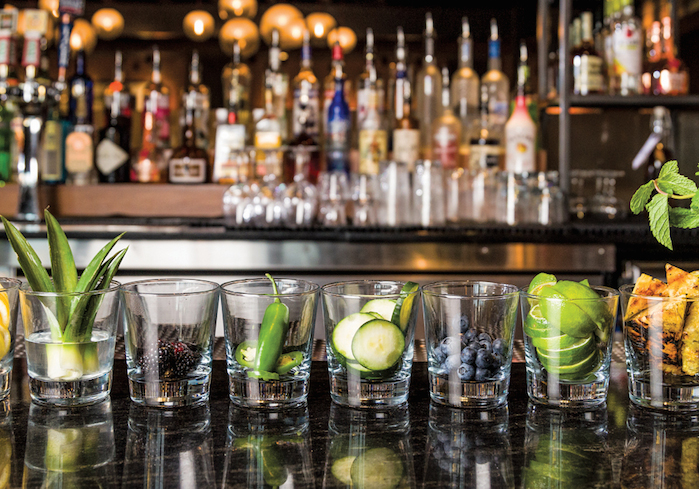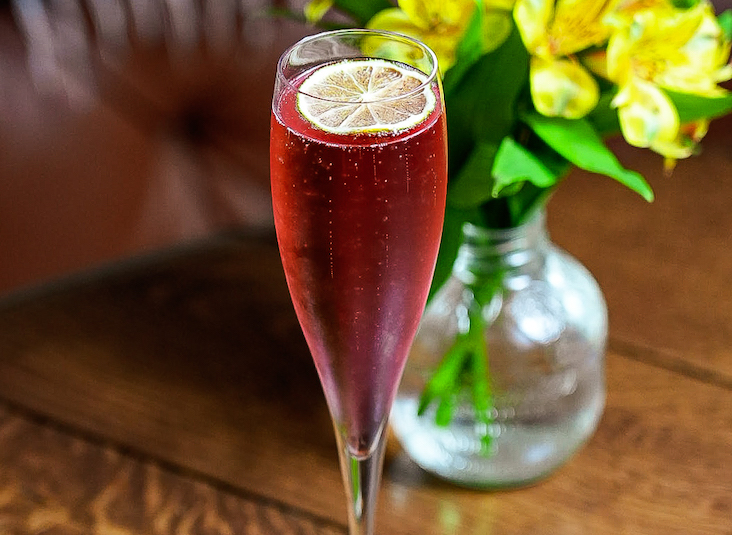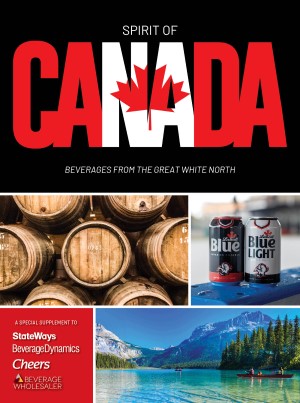When Kansas City restaurateurs Joe Gilbert and Paul Robinson opened the first Houlihan’s 45 years ago, there weren’t many options between fast food and fine dining. The brand helped create and shape today’s casual-dining category by offering quality food and unique beverage options at accessible price points.
As consumer tastes and habits have shifted in favor of local and fast-casual eateries, many casual-dining chain operators have struggled in recent years. How is Houlihan’s, which now counts 84 restaurants across 18 states, responding to these challenges?
It’s updating its decor and promoting fresh ingredients and scratch cooking, like many other operators in the space. Houlihan’s is also appealing to social media enthusiasts by creating Instagrammable cocktails.

Houlihan’s Beverage Director Mitchie Kanda, left, and CEO Mike Archer.
But it’s also emphasizing what made it successful, says Mike Archer, CEO of Houlihan’s Restaurants, which is quality for value. The chain still focuses on casual dining, but with an elevated experience, he notes.
Archer last year teamed up with private equity firm York Capital Management to buy the Houlihan’s Restaurants from private equity firm Goldner Hawn Johnson Morrison, which had obtained a majority stake in the company in 2006. The deal also included its fine-dining brands J. Gilbert’s Wood-Fired Steak & Seafood Restaurant, Bristol Seafood Grill and Devon Seafood+Steaks.
Archer, an industry veteran, oversees all aspects of the four restaurant brands. He previously served as president of Applebee’s from 2008 to 2014; before that he was president/chief operating officer of TGI Friday’s.
Part of enhancing the Houlihan’s guest experience will come from location remodels. The chain is working with designers, local artisans and skilled craftspeople to add polish to the décor, with modern furnishings and open kitchens, Archer says.
Recently completed remodels at the Prestonwood, TX, and Leawood, KS, restaurants reflect the new direction while keeping a distinct personality for the different locations. A little more than half of the Houlihan’s locations are franchised; the rest are corporately owned.
Thoroughly Modern Menus
Houlihan’s has become known for certain things, including its pitchers of Long Island Iced Tea. “They’re a legacy item, something that people have always associated with Houlihan’s,” Archer says.
This speaks to a challenge the company faces today, he notes: “How do you take drinks that have been around for a long time and modernize them for today while still embracing our heritage?”
The answer is customization and craft twists. For instance, Houlihan’ss now offers a Sailor Jerry Long Island Iced Tea, made with Sailor Jerry spiced rum, vodka, gin and house-made sweet-and-sour mix.
The Long Island Iced Teas are also available in fruity versions such as “Peach,” with Peachtree schnapps and cranberry juice, and “Raspberry,” with raspberry cordial and cranberry. They sell for $7.25 for a 14-oz. glass and $8.45 ($5 each during Happy Hour) for a 1-liter pitcher.
Houlihan’s also offers an Angry Orchard Long Island Iced Tea. Priced at $9 a glass, and $10.25 a pitcher ($7 per pitcher at Happy Hour), these are made with Jameson Irish whiskey, Absolut Citron vodka, Cointreau and Angry Orchard Crisp Apple hard cider.
The chain launched a seasonal “Garden to Glass” craft cocktail program this past summer. Inspired by the popular farm-to-table concept, the drinks focused on fresh fruit and herbs such as rosemary, blueberry, pineapple and jalapeños.
Garden-to-Glass cocktails included Blueberry Rosemary Lemonade, with Stoli Blueberi vodka, muddled blueberry, rosemary and house-made lemonade; Spicy Charred Pineapple, with Milagro Silver tequila, house sour, muddled charred pineapple and fresh jalapeño; and the Oaks Lilly, with Grey Goose vodka, cranberry juice, Triple Sec, fresh lemon juice and blackberry.
“A lot of our locations are close to farmers markets,” points out Mitchie Kanda, Houlihan’s beverage director. “We encourage our bartenders to go there and buy ingredients if their schedule allows.”
Houlihan’s also works with local producers in different markets to bring in fresh ingredients.
The Garden to Glass program is scheduled to run until October, “but there’s a possibility that one of these cocktails could stay on the menu,” Archer says. “We want what’s best for the guests. We’re always keeping an eye on those things that people seem to love.”
Crafting Cocktails
Rather than working with just one major spirits supplier, Houlihan’s cherry-picks the alcohol brands it believes will best help the chain develop the cocktails it’s looking for. The brand also relies on its bartenders to help innovate cocktails and provide feedback.
“We’re always listening to our bartenders because they know firsthand what customers are talking about and what they’re actually ordering,” Archer says. “When we’re creating new drinks, we don’t want to be so far out in front of the tastes of our guests that the drinks don’t sell.”
Kanda adds that Houlihan’s bartenders have a direct open line to her. They’ll email her when they see something interesting, or if they have come up with a recipe they think is worthy of her consideration.
The company prides itself in encouraging staff to try to develop drinks that can make it onto the menu, Kanda says. In this way, different Houlihan’s locations can have different drinks menus. She and her staff keep a close eye on trends, including the buzzwords on social media. “The tasting team will take the time to develop drinks through trial and error and then get together to decide what’s best,” Kanda says.
The results of these experimentations are modern cocktails, such as the Oak Aged Manhattan ($9.50). Served over a block of ice, it consists of Monkey Shoulder Scotch whisky, sweet vermouth, Angostura orange bitters and “magic,” with the menu bolding the final word.
Houlihan’s ages the cocktail onsite with orange peels and oak staves to impart notes of maple and vanilla, along with the smoothness of barrel aging within a shorter time period. Another innovative take is the Bleeding Rose ($9.50).
Houlihan’s bartenders combine brewed hibiscus tea with Aperol and freeze the mixture into ice cubes. Then they create a cocktail of St. Germain elderflower liqueur, Stoli vodka, fresh sour mix and pour it over the crimson Aperol-tea ice cubes.
As the ice gradually melts into the drink, the flavor changes over time. “Best. Drink. Ever,” the menu says, perhaps suggesting a suitable Instagram comment.

Houlihan’s signature Sailor Jerry Long Island Iced Tea, with Sailor Jerry spiced rum, vodka, gin and house-made sweet-and-sour, is also available in Peach and Raspberry versions.
Social Share-Worthy Tips
Speaking of Instagram, social media appeal has become a large part of the cocktail scene.
“We get a lot of people snapping pictures as they dig into their pitchers of Long Island Iced Tea,” says Archer. You have to think about social media when designing the visual component of a drink, notes Kanda. “You could choose not to include a garnish, but that’s not the right decision.”
You want the “wow” factor, she adds. “It’s so important that guests take photos of our cocktails.”
Houlihan’s has done some fun LTOs with garnishes: For Shark Week, every drink was sent out with a plastic toy shark that was about the size of the glass.
Archer agrees that more thought is needed now for cocktail presentation. When drinks are posted to social media, he says, they become another way to extend the brand presence and get more people talking about it.
Other cocktails have earned a number of social shares, such as the Ancho Margarita from the Garden-to-Glass menu. Served in a highly Instagrammable ceramic “jarrito” (little jug), the seasonal cocktail incorporates Milagro Silver tequila, Ancho Reyes chile liqueur, grilled pineapple, fresh lime juice and agave syrup. It’s garnished with a slice of grilled pineapple and a pineapple leaf.
Another social-media-friendly cocktail is the Blue Cheese & Bacon Martini ($9). It’s a shaken concoction with Chopin potato vodka, garnished with olives hand-stuffed in-house with gorgonzola cheese and served with the brand’s signature brown-sugar-candied bacon on the rim of the glass.
So Who is This Houlihan?
Houlihan’s started as a single restaurant in Kansas City opened in 1972 by Joe Gilbert and Paul Robinson. So where did the name Houlihan’s come from?
The Gilbert/Robinson restaurant firm included the Plaza III Steakhouse in Kansas City’s Country Club Plaza, which was America’s first suburban shopping district. Next door to the steakhouse was the clothing store called Tom Houlihan’s.
When the apparel shop announced that it would vacate the space, Gilbert/ Robinson decided to expand and take over the location. Rather than build out Plaza III Steakhouse, they wanted to create something fresh, but they could not decide on a name this venture.
The architect labeled the space on the plans “Tom Houlihan’s old place,” and the name stuck. Gilbert/Robinson received permission from Tom Houlihan himself to name their new restaurant Houlihan’s Old Place. (The Old Place was eventually phased out of the name and logo.)
In return, Gilbert-Robinson agreed to leave a table in the middle of the business permanently reserved for Tom Houlihan so long as he was living. It even bore a brass plaque with his name. Oddly enough, Houlihan never sat at the table—he didn’t even visit the restaurant once.
Quality Assurance
To ensure consistent drinks and service across locations, Houlihan’s provides recipe cards for every location. These four-color, index-sized laminated cards are hole punched and kept on a key ring behind the bar. “This is a great and quick tool bartenders use to ensure all drinks meet our expectations,” Kanda says.
Along with these recipe cards, each location makes the new cocktails for their staff meeting before each shift starts. “Since we free-pour at Houlihan’s, we also have each bartender perform a pour test before setting foot behind the bar to start their shift,” Kanda says. “There are so many things that can contribute to how fast spirits pour—from the weather to the bartender’s emotions—so we always want to make sure they adjust appropriately so each pour is the same.”
Houlihan’s also encourages its bartenders to taste test, and adjust along the way. Especially when working with farm-fresh ingredients, Kanda notes, there can be lack of consistency, so tasting is important.
When launching a new limited-edition program, Houlihan’s will stagger the rollout. That way managers can catch any unexpected kinks in the program before it goes national, and tinker to see what works best.
For instance, the Garden to Glass program details were communicated on April 24, and the stores had until May 18 as their deadline to roll out. Once they have the details for rollouts, the regional locations can plan when they want to execute per store, making sure that training is set and that all staffers are aware of the changes beforehand.
A Local Craft Beer Lineup
Creating the Houlihan’s beer list is largely left up to the location staff. This is a recent change, enacted in the past year, to shift the focus of the beer menu toward local brews. Each unit has four to 18 taps.
Furthermore, whereas many chain restaurants have a mandatory draft list— normally including several macro brands—Houlihan’s has a mandated style list. At the top of that list are the top-selling styles: light lagers, IPAs, wheat beers, shandies and so on.
As the list goes on, for locations with enough taps, different styles come into play, such as stouts and porters, or a second IPA. If appropriate, these can all come from local breweries. This allows Houlihan’s locations to hold beer tastings and dinners featuring a specific microbrewery, so long as the producer can provide multiple styles of beer.
At the Overland Park, KS, Houlihan’s location, for instance, three of four handles on one set of taps are devoted to the regional Boulevard beers (a wheat beer, pale ale and radler at press time), the fourth tap served Samual Adams lager. On another set, two of four tap handles offer beers from Martin City Brewing Co. in South Kansas City (Hardway IPA and Abbey Belgian Ale); one is a dunkel style from Kansas City Bier Co. and the fourth is for Bud Light.
The mandated list also keeps Houlihan’s from serving too much of one style, such as tap lines that feature seven different takes on an IPA, or beers so esoteric that few if any guests at a casual-dining chain would order them.
Fine-tuning the Wine List
When it comes to the Houlihan’s wine list, which usually runs about 35 bottles at each restaurant, variety is the goal. “We want to have different varietals for different wine-drinkers at different price points,” Kanda says.
She has been fine-tuning the wine list: “I knew that there was wine on the list that never sold because they just weren’t right for our guest.”
Another issue: “We had all these wines, some with ‘fancy’ names that our staff didn’t really know how to pronounce or feel comfortable selling.”
Kanda took the wine list down to the bare minimum, offering the varietals needed for an abbreviated list.
“We trained our staff on these core wines first, building up their knowledge and confidence,” she notes. “Slowly we started to build on the wine list, introducing different wines and keeping up with the wine trends.”
Houlihan’s now offers a list “that has something for every one of our guests, but the most important part is that the staff feels confident when selling it,” Kanda notes.
On the menu the wine list is broken down into red, bubbles and white. Within those broad categories, the list zeros in further by grouping by varietal or style: merlot, pinot noir, red blends, riesling, chardonnay, etc.
The varietals/styles proceed progressively on the menu. Reds go from lighter to spicier and fruitier to more juicy to rich and powerful. Whites advance from sparkling to sweet to cool and crisp to fully luscious. This offers waiters some guidance in recommending wines based, and gives customers more information to work with when ordering.
Houlihan’s sells its wines by the glass in 6-oz. and 9-oz. sizes. On Tuesday nights some locations will offer half-off prices for all wine bottles.

The Meatloaf No. 9 paired with the Blue Cheese & Bacon Martini, made with Chopin potato vodka, garnished with olives hand-stuffed in-house with gorgonzola cheese and Houlihan’s signature brown-sugar-candied bacon.
Houlihan’s Heritage
Throughout the brand’s evolution, “fresh ingredients have always been important,” Archer says. But guests today have come to expect natural and local fare from restaurants, even national chains.
At Houlihan’s, all soups are made from scratch, as are most dressings and sauces, salsa, pico de gallo, guacamole, the famous fajita marinade and most desserts, according to the company’s culinary director/chef Michael Slavin.
What’s more, Houlihan’s this past summer rolled out a “Field + Farm” special menu that featured fresh seasonal food items. This went hand in hard, or perhaps farm and garden, with the seasonal cocktail menu.
When the culinary team decided to focus the spring and summer menu around fresh seasonal items that you would find at a farmers market, and flavors familiar to backyard barbeques, the bar team followed suit with the Garden to Glass cocktail LTO. A past fall/winter LTO focused on “better-for-you” options, such as low calorie, high-protein and vegetarian offerings. Kanda wanted drinks to go along with that same theme, “so we rolled out LTO drinks that had zero-calorie mixers (from Be Mixed), used natural sweeteners such as honey, and spirits that were made with real coconut water.”
This speaks to a core strategy of Houlihan’s: The company always tries to line up the drinks and food menus so that they reflect one another and make for natural food/beverage pairings. What are some of the recent unique food/cocktail pairing synergies? One is the Blue Cheese Bacon Martini paired with the Meatloaf No. 9 (named such, the chef says, because it took eight failed recipes to get it perfect). Another is the Spicy Charred Pineapple cocktail with the Jalapeño Popper Stuffed Chicken Breast.
While Houlihan’s stays fresh by evolving and innovating, it has some classics that it won’t change.
For instance, the stuffed chicken breast ($16.95) was on the original menu from 1972. A crisp, panko-breaded chicken breast stuffed with garlic-herb cream cheese, the dish is recommended with a glass of La Marca prosecco, according to the menu.
“Our heritage is rooted in the grill and the bar,” Archer says. “It’s always been about serving customer quality food and the role the bar plays in that.”
The energy between the two provides restaurant guests with an elevated experience, Archer adds. “Both parts of the business are equally important in what we’re doing.”
Kyle Swartz is managing editor of Cheers magazine. Reach him at kswartz@epgmediallc.com or on Twitter @kswartzz. Read his recent piece Craft Beer Showed Signs of Slowdown in 2016.







